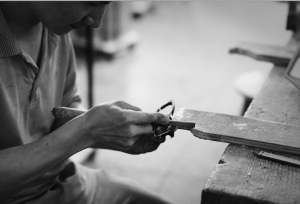If you have never been inside a factory or been a part of the eyewear design process it can be difficult to understand frame quality and price distinction when shopping for glasses. Our friends at Vision Monday, an optical industry publication, have spoken to the product developers who are making today’s eyewear and have broken it down for us. The production steps, materials, details and costs that go into the construction, distribution and marketing all account for why frames cost what they do. Here are a few of the many cost determinants mentioned in a recent article by Vision Monday’s senior editor, Deirdre Carroll.
Keep in mind that research and development are not free. Mark Ginsberg, Marchon’s senior vice president of global marketing tells Carroll, “Eyewear is the only product that is both a medical device and considered a fashion element. Eyewear, unlike other accessories, is a medical device for vision correction and protection and must pass all legal standards in the industry, which is actually extremely complicated, controlled and protected. There are many steps involved in producing a frame so that they not only look good but feel good on your head, protect your eyes and are built for longevity and daily use.”
The materials used to build a frame also play a large role in cost. The prices of various plastics and metals vary widely and significantly relate to quality. Premium materials like acetate and titanium are more expensive and require sophisticated machinery and skill to use. The volume produced also directly relates to cost. Mass produced frames in turn are less expensive since larger batches of material are ordered. Handmade pieces with complex details and limited edition styles will come with a higher price tag since the quantity produced is lower and the attention to detail is greater. That attention to detail can be what ultimately attracts us to a particular frame. Details such as hand polished finishes, semi-precious stones and unique hinges will have a huge impact on what that frame will cost.
The countries in which frames are produced also have an effect on the final cost. Skill levels and labor costs vary depending on where the factory is located, but more importantly so do laws and regulations that insure factories are socially compliant. Companies using factories that are compliant with laws associated with labor, safety, health and the environment incur higher production costs than factories that ignore the laws.
At the end of the day, not all eyewear is created equal. The quality of a frame can usually be felt when trying it on and seen when holding it. Superior materials will last longer and fit more comfortably. However, details that are not always visible can help provide a more positive wearing experience. To read the full article-
http://www.visionmonday.com/business/suppliers/article/frame-works/



